The popular Panasonic LX-series has received a rather modest update with the arrival of the new LX7 model. The aperture ring and ND filter button are welcome additions to an already proven design that particularly appeals to more experienced photographers, while the fast f/1.4 lens helps to creates dreamy out-of-focus backgrounds and the 11fps burst mode captures all the action, but with cameras like the recent Sony CyberShot DSC-RX100 delivering better image quality in a smaller package, not to mention the explosion in the number of compact system cameras, the premium-priced LX7 faces fiercer competition than ever before.
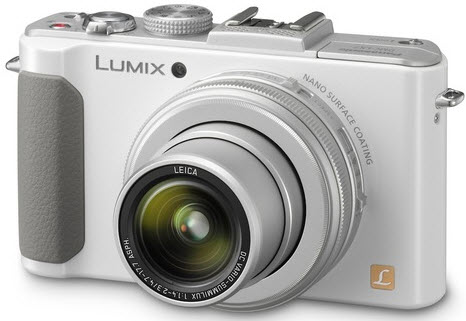
![]() Pros
Pros
![]() Polished and refined design
Polished and refined design
![]() Excellent lens with ultra-fast aperture
Excellent lens with ultra-fast aperture
![]() Plenty of useful shooting features
Plenty of useful shooting features
![]() Hotshoe accessory port can accommodate an EVF
Hotshoe accessory port can accommodate an EVF
![]() Cons
Cons
![]() Screen needs to be even better to match its rivals
Screen needs to be even better to match its rivals
![]() No articulating/flip-out screen
No articulating/flip-out screen
![]() Smaller sensor than rivals
Smaller sensor than rivals
Introduction
The Panasonic Lumix DMC-LX7 is a premium compact digital camera with a fast lens, full range of manual shooting modes and RAW file support. The new LX7 aims to build on the success of its LX5 predecessor with a new 3.8x, 24-90mm f/1.4-2.3 zoom lens, large 1/1.7-inch 10 megapixel MOS sensor, an ISO range of 80-12,800 and 1920x1080 50p Full HD movie recording with a Creative Movie Mode for adjusting both the shutter speed and aperture. The LX7’s aperture ring and rear dial provide full control over the aperture range, while an internal neutral density filter allows slow shutter speeds to be used in combination with fast aperture settings. The Panasonic Lumix DMC-LX7 is available now in black or white for £449.99 / $499.95.
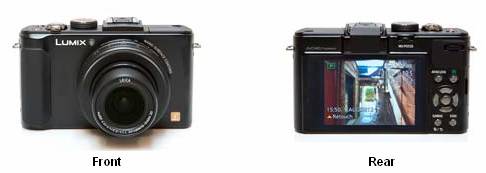
Panasonic Lumix DMC-LX7 key features
![]() Fast F1.4 - F2.3, 24-90mm equivalent lens
Fast F1.4 - F2.3, 24-90mm equivalent lens
![]() Built-in 3 stop neutral density filter
Built-in 3 stop neutral density filter
![]() 10.1 MP multi-aspect ratio 'High Sensitivity MOS' sensor (1/1.7"-type, 12.7 MP total)
10.1 MP multi-aspect ratio 'High Sensitivity MOS' sensor (1/1.7"-type, 12.7 MP total)
![]() ISO 80-12800
ISO 80-12800
![]() Aperture ring around lens barrel, combined ND/manual focus control on rear
Aperture ring around lens barrel, combined ND/manual focus control on rear
![]() 11 fps continuous shooting, 5 fps with AF tracking
11 fps continuous shooting, 5 fps with AF tracking
![]() 920K dots 3" screen with Anti-Reflective coating
920K dots 3" screen with Anti-Reflective coating
![]() Full HD 60p/50p video, built-in stereo microphones
Full HD 60p/50p video, built-in stereo microphones
![]() Port for DMW-LVF2 accessory electronic viewfinder
Port for DMW-LVF2 accessory electronic viewfinder
![]() High-speed video recording at 120fps (NTSC) / 100fps (PAL) in 720p MP4 format
High-speed video recording at 120fps (NTSC) / 100fps (PAL) in 720p MP4 format
Multiple aspect ratio sensor
Like the LX5 and the Micro Four Thirds Lumix G DMC-GH2 (and the LX3 and GH1 before them), the LX7 uses a multi-aspect ratio sensor. It's slightly 'oversized', meaning that at any given aspect ratio the camera only uses a crop from the total available sensor area. It's designated as a '1/1.7" type' sensor, which means that at 4:3 the active area is about the same as a conventional 1/1.8" type.
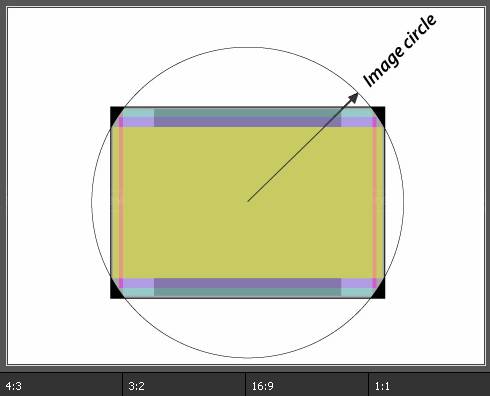
At first sight this approach may seem strange, but the result is that the lens offers the same diagonal angle of view regardless of the selected aspect ratio (apart from 1:1), making it much easier to get a feel for the behavior of the lens. It also means you make the most of the sensor area, getting similar pixel counts in all modes.
Sensor sizes compared
To put the LX7's slightly-smaller sensor in perspective, here it is compared in size to those found in some other enthusiast compact cameras. It's substantially smaller than the 1" sensor Sony has used in its DSC-RX100, or indeed the Fujifilm X10's 2/3" EXR-CMOS. But it's only fractionally smaller than the LX5's CCD, and the difference is more-than-made-up by the LX7's stop-faster lens.
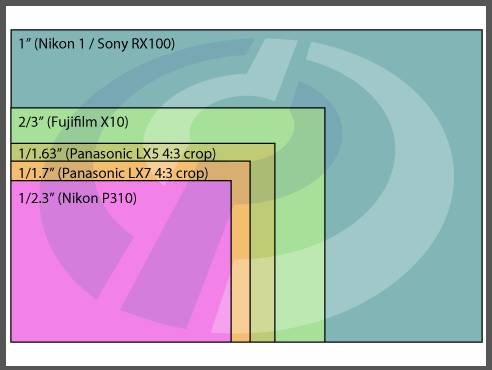
The LX7's 1/1.7"-type sensor is smaller than the LX5's 1/1.63"-type, but not by very much. (Note that the Olympus XZ-1 and the Samsung EX-2F both use a similar sensor area to the LX5's 4:3 crop.)
Size compared to the Fujifilm X10, Olympus XZ-1 and Canon Powershot S100
In this company the Fujifilm X10 is the biggest camera, but it does have the largest sensor, a mechanical zoom ring and an optical viewfinder. The Olympus XZ-1 is almost exactly the same size as the LX7, with the main difference being its longer but less-wide 28-112mm equivalent lens. Meanwhile the Canon Powershot S100 is the smallest of all here, but offers no hot shoe or external viewfinder option and has the slowest (but widest-range) lens.

Left to right: Fujifilm X10, Olympus XZ-1, Panasonic Lumix DMX-LX7, Canon Powershot S100.
If you're new to video editing and intend to import Panasonic Lumix DMX-LX7 MP4 recordings to Avid Media Composer Mac version to make your own masterpieces, you can try to convert Panasonic LX7 MP4 to DNxHD, the Avid MC preferred format for smooth editing.
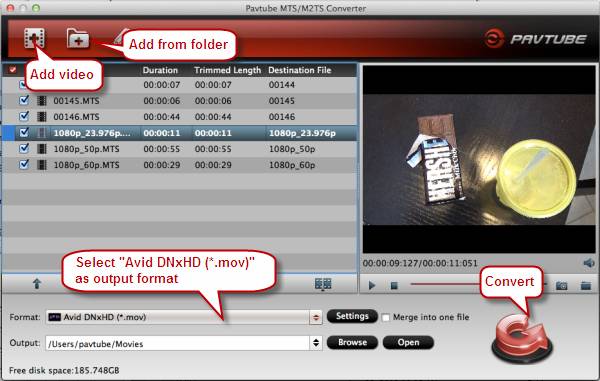
Open up Pavtube MTS Converter for Mac, and load your source MP4 files into it. Select “Avid DNxHD (*.mov)” as output format. Finally, click “Convert” button to start transcoding Panasonic DMC-LX7 MP4 to DNxHD MOV for Avid MC. See detailed steps on making Panasonic LX7 compatible with Avid Media Composer.
Useful Tips
- MXF to Avid Converter allows You to Convert 1080p HD MXF for Avid Editing
- Transcode Panasonic AVCHD MTS to Avid Media Composer DNxHD MOV
- Sony VG900/VG30 MTS and Avid workflow - edit NEX 50p/60p AVCHD with Avid MC
- Convert Sony AVCHD MTS/M2TS clips to DNxHD MOV for Avid Media Composer
- How to get Avid Media Composer working with AVCHD MTS footage?
- Transcode Panasonic Lumix DMC-FX75 AVCHD Lite MTS to Avid, Premiere, Sony Vegas, Pinnacle


 Home
Home Free Trial MTS/M2TS Converter for Mac
Free Trial MTS/M2TS Converter for Mac





